
How to change the cover on a Cousin Constrictor
by Aleix Escorsell 30 Oct 2019 02:00 PDT
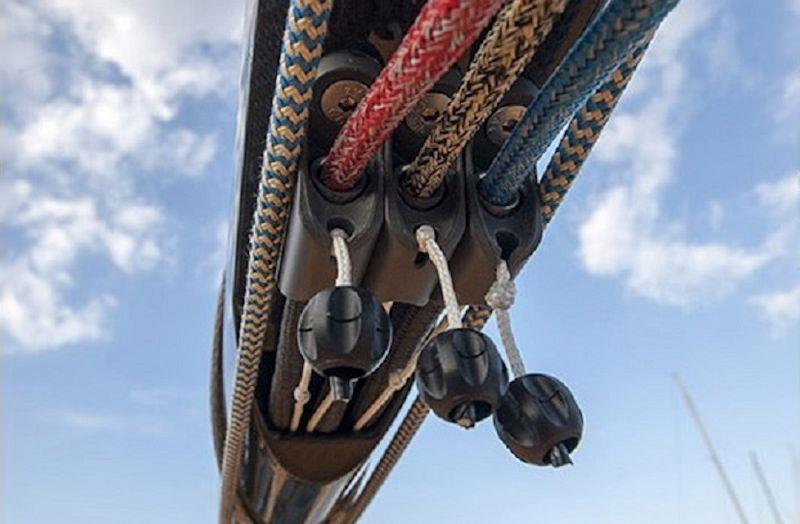
Cousin Trestec Constrictor - A Textile Rope Clutch © Berschi
Created as a lightweight alternative to traditional metal clutches, the Cousin Constrictor© is a great bit of kit for reliably holding rope under load with great longevity when properly maintained.
Rope innovators, Cousin are at the cutting edge of marine rope and textile technology and have been able to revolutionise the French racing scene with great products such as the Cousin Constrictor©.
Cousin claim that their Constrictor is three times lighter than metal alternatives and twice as powerful. Coupled with the fact that the Cousin Constrictor© does not damage the line in any way makes it a great alternative to traditional rope clutches for a variety of boats and yachts.
This blog will help owners of the Constrictor, and those looking to purchase this versatile textile rope clutch, learn more on how to properly maintain and increase the lifespan of the Constrictor. With a step by step guide, and examples provided by Cousin, you will be able to confidently look after your Constrictor and change the cover if needed.
Looking after your Cousin Constrictor©
The sleeve is made of a high tenacity black technora, which is extremely sun and heat resistant, and the casing is made of an anodized aerospace-grade aluminium housing.
All of this makes the Constrictor a reliable and extremely durable clutch. However, as with any textile product, usage does wear on the sleeve over time. Cousin recommends a few tips and tricks to improve the lifespan of your Constrictor:
- Avoid over-loading where possible. The Constrictor can hold as much as the rope can, and grip actually increases with load! That said, high load over time will eventually wear the Constrictor and can lead to damage.
- Regularly wash the Constrictor© with fresh water. Harmful compounds such as sand, sea water, sharp equipment and chemicals can do damage to the Constrictor. Washing with fresh water will help improve longevity.
- In winter, uninstall the Constrictor or use a cover when not in use.
- Avoid cleaning the Constrictor with high pressure cleaners that may introduce abrasive elements into the fibres.
Even with excellent maintenance, wear and tear may lead you to require a replacement sock, but how do you know when to change?
Here are a few key things to look out for:
- Is there any obvious damage such as cuts or tearing?
- If you can see the rope beneath the sock, it may be time to change your cover.
- Is the cover fraying or fluffing up?
- If the pattern on the cover is no longer consistent or you can see strands that have detached from the main sock, this could be a sign that your cover needs to be replaced.
Particular attention should be paid to the junction between the braided sock and the cone fitting. This is where the sock exits the aluminium fitting and the most likely point of significant damage.
If you do see damage to the cover, it's important to assess the damage and change it if necessary. Below is a step by step guide on how to change the cover.
Changing the cover of your Cousin Constrictor
Step 1 - Remove the Cousin Constrictor© from your boat
Changing the cover while the Constrictor is attached to the boat may cause damage to the Constrictor and the boat. Therefore, we recommend removing it before you begin the process.
Step 2 - Insert the metal punch (see note below on this custom tool) into the same hole that the cover comes out of, pushing the cover aside as you do so.
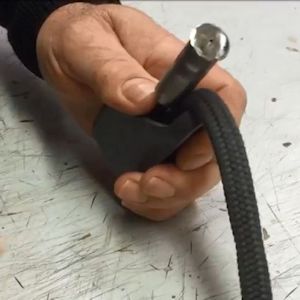
Step 3 - Bash the top of the punch with a hammer to release the titanium ring. It should come out of the bottom.

Step 4 - Remove the titanium ring and the cover from the housing and set them aside.
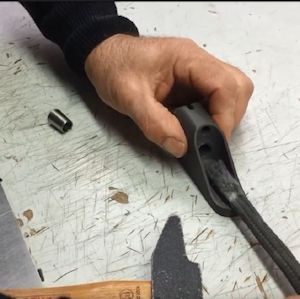
Step 5 - Insert the new cover into the housing and pull it through to the other side.
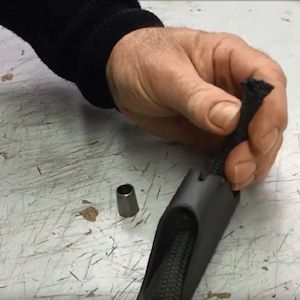
Step 6 - Carefully splay apart the fibres to allow the titanium ring to fit comfortably inside the end of the cover, then insert the titanium ring into the end of the cover, thinner end first.
It's important to ensure that the fibres are evenly spread around the titanium ring to ensure that the load is spread equally throughout the cover.
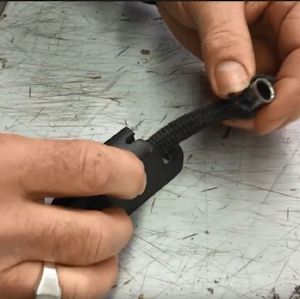
Step 7 - Ensuring that the ring stays encased in the cover, Pull the cover back through the housing and push the ring in to the hole. N.B. You should be able to see the cover all the way around the ring.
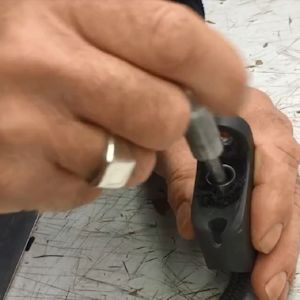
Step 8 - Using the punch and a hammer, punch the ring in to the housing. It should now be jammed in and unable to move and you should still be able to see the cover all the way around the edge of the ring. Pull on the end of the cover to ensure it is secure.
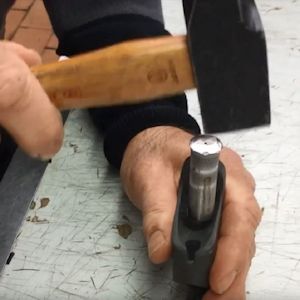
Ensure that you test your Constrictor with a light load before you sail.
With this guide you should be able to get the most out of your Cousin Constrictor©. Don't forget to regularly check your Constrictor for cuts and tears, regularly wash it with fresh water and avoid overloading it.
Footnote:
In order to change the cover yourself, you will need a punch (pictured below), specifically designed for this operation. The tool needs to be two thicknesses, the thin end needs to be able to fit inside the aluminium ring and the thick end needs to have the same diameter as the OD of the titanium ring.
While Cousin do not currently sell this tool, we recommend that you contact them regardless, as they are considering releasing them as a product in the future. If not, any decent metal shop would be able to craft the correct tool and upffront.com can supply the dimensions.
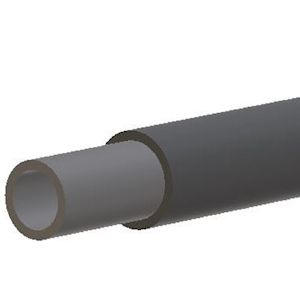
It's important to stress that this tool is critical because it ensures that the aluminium housing is not damaged, and the structural integrity of the clutch is not compromised during the sock replacement process.
If you do not feel confident in doing it yourself, take your Constrictor to a local rigger for assistance.
If you have any questions about the specifications of the Cousin Constrictor©, or to buy a new cover, visit upffront.com or alternatively use the contact form.